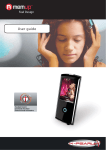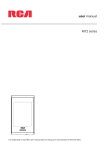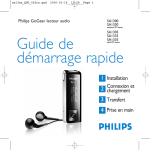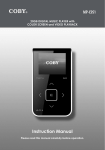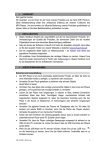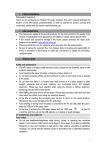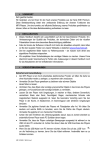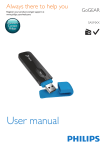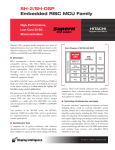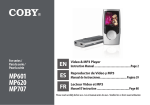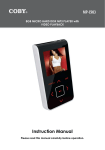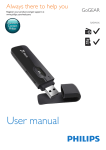Download COBY electronic MP-C351 User's Manual
Transcript
MP-C351 Portable MP3 Micro System with 512MB Integrated Flash Memory and SD/MMC Card Slot Instruction Manual Please read this manual carefully before operation. SAFETY INSTRUCTIONS CAUTION For Customer Use: Enter below the serial number that is located on the bottom of the unit. Retain this information for future reference. RISK OF ELECTRIC SHOCK DO NOT OPEN CAUTION: TO REDUCE THE RISK OF FIRE AND ELECTRIC SHOCK, DO NOT REMOVE THE COVER (OR BACK) OF THE UNIT. REFER SERVICING ONLY TO QUALIFIED SERVICE PERSONNEL. Model No. MP-C351 Serial No. The lightning flash with arrowhead symbol within an equilateral triangle is intended to alert the user to the presence of uninsulated “dangerous voltage” within the product’s enclosure that may be of sufficient magnitude to constitute a risk of electric shock. The exclamation point within an equilateral triangle is intended to alert the user to the presence of important operation and servicing instructions in the literature accompanying the appliance. WARNING: To prevent fire or shock hazard, do not expose this device to rain or moisture. WARNING: Handling the cords on this product will expose you to lead, a chemical known to the State of California to cause cancer, and birth defects or other reproductive harm. Wash hands after handling. CAUTION: To prevent electric shock, match wide blade of plug to wide slot of outlet and fully insert. For recycling or disposal information about this product, please contact your local authorities or the Electronics Industries Alliance: www.eiae.org. -- SAFETY INSTRUCTIONS 1. Read these instructions carefully. Keep these instructions for future reference. 2. Heed all warnings and follow all instructions. 3. Do not expose to water or moisture. 4. Clean only with a dry cloth. 5. Keep objects away from ventilation openings. Do not block ventilation openings at any time. 6. Do not install near any apparatus that produces heat such as stoves, radiators, amplifiers, etc. 7. Do not force the power plug into a wall outlet. If the plug provided does not fit into your outlet, consult an electrician for replacement of the obsolete outlet. (A polarized plug has two blades where one is wider than the other; the wide blade is provided for your safety.) 8. Do not place heavy objects on the power cord. Protect the cord from being walked on, pinched by objects, or torn and exposed to liquids (especially at plugs, convenience receptacles, and the point at which they exit from the device). 9. Use only with attachments/accessories specified by the manufacturer. Use of attachments/ accessories not recommended by the product manufacturer may be hazardous. 10. Unplug the device during lightning storms. Unplug the device and remove any batteries when the device will be unused for long periods of time. 11. Do not use this device near water. Do not place objects filled with liquids (eg, vases) on the device. 12. Do not use headphones/earphones while cycling, driving, or operating a motorized vehicle. 13. Do not use headphones/earphones at high volume. 14. Do not drop or otherwise subject the device to impact. 15. Do not disconnect the USB cable or turn off the device while transferring files to or from your device. Data loss may occur as a result. Users are responsible for creating backups of their data. COBY Electronics cannot be held liable or be otherwise responsible for loss of data. 16. Do not open or attempt to repair this device. Refer all repairs to authorized service personnel. -- TABLE OF CONTENTS SAFETY INSTRUCTIONS.................................................................................................................... 2 TABLE OF CONTENTS....................................................................................................................... 4 FEATURES.......................................................................................................................................... 6 PACKAGE CONTENTS..................................................................................................................... 7 LOCATION OF CONTROLS............................................................................................................. 8 LCD DISPLAY.................................................................................................................................... 9 POWER SUPPLY.............................................................................................................................. 10 Battery Operation...................................................................................................................10 AC Adapter Operation.............................................................................................................10 SD/MMC CARD INSTALLATION.....................................................................................................11 CONNECT TO A COMPUTER........................................................................................................ 12 USB Driver Installation...........................................................................................................12 Microsoft Windows 98 SE..............................................................................................12 Connecting to a Computer......................................................................................................12 Disconnecting from a Computer.............................................................................................12 Microsoft Windows.........................................................................................................12 Macintosh OS X..............................................................................................................13 Transferring Files....................................................................................................................13 Microsoft Windows.........................................................................................................13 Macintosh OS X..............................................................................................................13 BASIC OPERATIONS...................................................................................................................... 14 Standby Mode.........................................................................................................................14 Power On/Off..........................................................................................................................14 Menu Navigation.....................................................................................................................14 MAIN MENU OVERVIEW............................................................................................................... 15 NAVIGATION MODE (NAV).......................................................................................................... 16 Navigation Controls................................................................................................................16 Music.......................................................................................................................................16 Voice.......................................................................................................................................16 Play List (M3U)........................................................................................................................16 SD/MMC Card.........................................................................................................................16 MUSIC MODE (MSC)..................................................................................................................... 17 Music Controls........................................................................................................................17 Repeat Play.............................................................................................................................17 Repeat A-B Function..............................................................................................................17 FM RADIO MODE (FM)................................................................................................................. 18 -- TABLE OF CONTENTS Manual Tuning.........................................................................................................................18 Preset Tuning..........................................................................................................................18 Store Preset Stations..............................................................................................................18 Store Presets Manually...................................................................................................18 Store Presets Automatically...........................................................................................18 Delete a Preset Station...................................................................................................18 AUXILIARY MODE (AUX)............................................................................................................... 19 Connect an External Audio Source........................................................................................19 RECORDING.................................................................................................................................. 20 Voice Recording......................................................................................................................20 Line-In Recording...................................................................................................................20 FM Recording.........................................................................................................................21 ALARM CLOCK.............................................................................................................................. 22 TIME SET MODE (SET).................................................................................................................... 23 Clock Set.................................................................................................................................23 Alarm Set................................................................................................................................23 SYSTEM MODE (SYS)...................................................................................................................... 24 EQ (Equalizer).........................................................................................................................24 Repeat Mode..........................................................................................................................24 Display....................................................................................................................................24 ID3 Tag............................................................................................................................24 Lyric.................................................................................................................................25 Contrast..........................................................................................................................25 B-Light Time (Backlight).................................................................................................25 Language........................................................................................................................25 Auto Off...................................................................................................................................26 Sleep Time..............................................................................................................................26 Recording................................................................................................................................26 REC Mode (Recording Mode)........................................................................................26 VAD (Voice Activated Detection)....................................................................................26 REC Input (Recording Input)..........................................................................................27 Resume...................................................................................................................................27 Track/Time Line..............................................................................................................27 Delete File...............................................................................................................................27 Format.....................................................................................................................................28 Reset.......................................................................................................................................28 Information..............................................................................................................................28 Alarm Mode.............................................................................................................................28 TROUBLESHOOTING...................................................................................................................... 29 SPECIFICATIONS............................................................................................................................ 30 -- FEATURES • 512MB Integrated Flash Memory • Plays Digital Music from Most Online Stores (Microsoft DRM 9 Support) • 4 Integrated Aluminum-Cone Speakers Deliver Superior Sound • LCD Displays Song Title, Album, and Artist Information (ID3 Tag Support) • SD/MMC Card Slot Allows for Expanded Memory Capacity (SD/MMC Card Not Included) • Mini USB Port for Fast File Transfers • FM Radio with 20-Station Preset Memory • Real-Time MP3 Encoding (No PC Required) • Digital Voice Recording through Integrated Microphone • Digital Equalizer Presets (Normal, Classic, Rock, Jazz, and Pop) • Alarm Clock Function (MP3, Radio, or Buzzer) • Sleep Timer • Mobile Music, Data, Document, and Picture Storage • Plug and Play: Supports Windows 98 SE (Driver CD Included), Windows ME, 2000, XP, and Mac OS X • Upgradable Firmware • Battery Operation with 4 x “C” Batteries (Not Included) -- PACKAGE CONTENTS MP-C341 Earphones Instruction Manual USB Cable AC Adapter Line-In Cable Installation CD (for Windows 98 SE) -- LOCATION OF CONTROLS DC Jack Headphone Jack AUX Line-In USB Port DC 6V SD/MMC Card Slot Previous / Navigation Left Volume + / Navigation Up Next / Navigation Right AUX LINE-iN CONNECTIONS PANEL Slide cover open in the direction of the arrow Volume - / Navigation Down Play/Pause CONNECTIONS A-B REC TIME EQ ALARM Repeat Time/ A-B Alarm Record/ Equalizer SNOOZE MENU Snooze Menu Play/Navigation Control -- Detachable Shoulder Strap (unscrew to detach) LCD DISPLAY Current Track Number File Type Voice File Alarm Battery Level Equalizer Music File Total Tracks File Format WMA MP3 02 0 NO RM 044 Play Mode MP3 MUSIC 01:16 128 44 KHZ KBPS Bit Rate Sample Frequency -- Elapsed Time POWER SUPPLY Battery Operation 1. Open the battery compartment. To remove the cover, slide it open in the direction of the arrow. . Insert the batteries. Insert 4 x “C” batteries, making sure to match the polarity of the batteries (+/-) with the markings on the inside of the battery compartment. Replace the battery compartment cover. 4 x “C” Batteries AC Adapter Operation 1. Open the Connections panel located on the rear of the player. Slide the cover open in the direction of the arrow. . Connect the player to a power source. Plug one end of the supplied AC Adapter to the DC Jack and plug the other end into a 100240V wall outlet. DC Jack NOTE: When the player is connected with the AC adapter, the LCD backlight will turn on and remain lit until the AC adapter is unplugged. When the player is running on batteries, the LCD backlight will light up briefly each time a button is pressed and then turn off. You can adjust how long the LCD backlight will remain on for through the SYS menu (see the SYSTEM MODE (SYS) section for details). - 10 - SD/MMC CARD INSTALLATION The integrated SD/MMC card slot lets you upgrade the player’s memory capacity easily with additional SD/MMC cards. To install an SD/MMC card: 1. Open the Connections panel. Slide the cover open in the direction of the arrow. . Insert the SD/MMC card with the metal contacts facing up as shown in the diagram below. Press the card in until you hear a click. 3. To remove the SD/MMC card, press the card in and it will spring back out. Note: Avoid touching the metal contacts of the SD/MMC card. Handle the card by its edges. - 11 - CONNECT TO A COMPUTER USB Driver Installation It is not necessary to install the USB driver if your computer is running Microsoft Windows ME/2000/XP or newer, or Macintosh OS X. Computers running these operating systems will recognize your player automatically when connected. Microsoft Windows 98 SE It is only necessary to install the USB driver if your computer is running Windows 98 SE. 1. Insert the Installation CD into your computer’s CD or DVD drive. Make sure to place the mini-CD in the center, recessed well of the drive tray. . Navigate to MY COMPUTER and double-click on the CD/DVD drive icon (usually “D:”). 3. Double-click on the folder “Win98 USB Drivers” and then on the folder “english”. 4. Double-click on the SETUP icon (SETUP.EXE) to start the USB driver installation program. 5. Follow the on-screen instructions to complete the installation and then restart your computer. Note: Mini-CDs should only be used in normal tray-loading CD/DVD drives. Mini-CDs may be used in slot-loading drives with the proper adapter; please contact your computer or drive manufacturer for more information. Connecting to a Computer To connect the player to your computer: 1. Turn the player off to place it in Standby mode. . Open the Connections panel. Connect the player to your computer with the supplied USB cable as shown in the diagram. 3. Your computer will recognize the player as a Removable Disk. If you have installed an SD/MMC card in the player, your computer will recognize the card as a second Removable Disk. Disconnecting from a Computer Disconnect your player as instructed below to prevent data loss or corruption. Microsoft Windows 1. Double-click the green arrow in the taskbar located on the lower-right side of the computer screen (Safely Remove Hardware). . Select “USB Mass Storage Device” from the list that appears and then click on “Stop”. 3. Select “USB Mass Storage Device” from the list that appears and then click on “OK”. - 12 - CONNECT TO A COMPUTER 4. Disconnect the USB cable from the player and your computer. Macintosh OS X 1. On the left side of the Finder window, identify the appropriate Removable Disk icon. . Click on the “Eject” arrow on the right of the Removable Disk icon. 3. Disconnect the USB cable from the player and your computer. Transferring Files The USB connection makes it easy to transfer music files (MP3/WMA) or any other data quickly between the player and your computer. • Operate the player on AC power to ensure uninterrupted transmission of files. • Do not disconnect or otherwise interrupt the player during transmission - this could damage or corrupt the player’s firmware. If the player is accidentally disconnected and is not working properly, unplug the player and remove the batteries for 3 seconds and then try again. Microsoft Windows 1. Open a Windows Explorer window. Locate the files or folders you would like to transfer from your computer. Select the files/folders with the mouse and press CTRL-C (copy) on the keyboard. . Navigate to MY COMPUTER and double-click on the Removable Disk icon. The computer will display all files and folders currently stored in the player. 3. Press CTRL-V (paste) on the keyboard to transfer the files you selected in Step 1 to the player. Macintosh OS X 1. Open a Finder window. Locate the files you would like to transfer from your computer. Select the files/folders with the mouse and press APPLE-C (copy) on the keyboard. . Click on the Removable Disk icon located on the left side of the finder window. The computer will display all files and folders currently stored in the player. 3. Press APPLE-V (paste) on the keyboard to transfer the files you selected in Step 1 to the player. Note: You may also use the mouse to drag-and-drop files between the player and your computer. If you need further assistance with transferring files, please refer to your operating system’s instruction manual or on-screen help. - 13 - BASIC OPERATIONS Standby Mode The player will enter Standby mode automatically when it is connected to a power source. The LCD will display the time (Clock) in Standby mode. Power On/Off • To turn the player on, press • To turn the player off, press and hold while in Standby mode. . Note: To display the time while the player is on, press and hold TIME/ALARM. The LCD will return to a normal display after a few seconds. Menu Navigation To access the Main menu, press MENU while the player is on. • Press / / / to move the selection left/right/up/down, respectively. • Press • Press MENU to cancel or return to the previous menu. to confirm a selection. - 14 - MAIN MENU OVERVIEW Use the Main menu to select and enter the different player modes shown below. To access the Main menu, press MENU while the player is on. NU MENU NAV NAVIGATION Music, Voice, Play List (M3U), SD/MMC Card MSC MUSIC FM AUX FM Radio AUXILIARY (External Audio Input) SET SET (TIME SET) Clock Set, Alarm Set SYS SYSTEM: EQ, Repeat Mode, Display, Auto Off, Sleep Time, Recording, Resume, Delete File, Format, Reset, Information, Alarm Mode - 15 - NAVIGATION MODE (NAV) Enter Navigation mode to browse the files and folders stored in the player or SD/MMC card. To enter NAV mode, select and confirm NAV in the Main menu. The NAV options are: • Music • Voice • Play List (M3U) • SD/MMC Card Navigation Controls • Press • Press / to move up/down the list of files/folders, respectively. to confirm a selection. • If a folder is selected, the contents of that folder will be displayed. Press to return to the previous folder. • If an audio file is selected, the player will switch to MSC mode and playback of the file will commence. Music Select and confirm MUSIC to find audio files (eg, MP3, WMA) in the “Root” folder of the player. Voice Select and confirm VOICE to find recorded audio files in the “Record” folder of the player. The player will place all recorded files in this folder. (See the Recording section for details about how to record with the player.) Play List (M3U) Select and confirm PLAY LIST to find playlist (M3U) files stored in the “Playlist” folder of the player. SD/MMC Card If you have installed an optional SD/MMC card, you may select and confirm SD/MMC CARD to find any files or folders stored on the card. (See the SD/MMC Card Installation section for details about how to install SD/MMC cards.) - 16 - MUSIC MODE (MSC) Enter Music mode to start music playback. To enter MSC mode, select and confirm MSC in the Main menu. (Playing an audio file in NAV mode will place the player in MSC mode as well.) Music Controls • Press to play a track. Press again to pause playback. Press paused to stop playback completely. • Press to skip to the next track; press and hold to fast forward through the current track. • Press to skip to the previous track; press and hold to reverse through the current track. • Press • Press REC/EQ to cycle through the digital equalizer settings (Normal, Classical, Live, Pop, or Rock). / or while playback is to adjust the volume level up/down, respectively. Repeat Play Repeat Play options can be changed in the SYSTEM menu. The Repeat Play options are Normal, One, All, Intro, and Random. (See the SYSTEM MODE (SYS) section for details.) Repeat A-B Function The Repeat A-B function allows you to set a segment of a track to be played repeatedly. 1. Press A-B to set the start point (A) of the track segment to be repeated. The Play Mode Indicator will display . . Press A-B again to set the end point (B) of the track segment. The segment will now play in a loop and the Play Mode Indicator will display 3. Press A-B again to resume normal playback. - 17 - . FM RADIO MODE (FM) Enter FM Radio mode to listen to FM radio broadcasts. To enter FM mode, select and confirm FM in the Main menu. There are two methods of tuning into stations: MANUAL and PRESET. When the player is in PRESET mode, the current preset station number will be displayed in the upper-left corner of the screen. Press to change between these two modes. Manual Tuning Place the player in MANUAL tuning mode, then: • Press to increase the station frequency; press and hold with a broadcast signal. to seek the next highest station • Press to decrease the station frequency; press and hold with a broadcast signal. to seek the next lowest station Preset Tuning Place the player in PRESET tuning mode, then: • Press / to select the next/previous preset station. Store Preset Stations Your player can store up to 20 station presets (01 to 20). Store Presets Manually Place the player in MANUAL tuning mode, then: 1. Tune to the station you want to store as a preset (eg, 91.5). . Press A-B. The Preset Station indicator on the screen will start blinking. 3. Press / to select the desired Preset number (eg, 01). 4. Press to confirm and store the station (eg, Preset 01 is now set to the station 91.5). Store Presets Automatically With the player in either PRESET or MANUAL tuning mode: • Press and hold MENU. The player will automatically seek and store the first 20 frequencies with a broadcast signal. This will overwrite previously stored preset stations. Delete a Preset Station Place the player is in PRESET tuning mode, then: 1. Press / to select the preset station to delete. . Press A-B to delete the preset station. - 18 - AUXILIARY MODE (AUX) Enter Auxiliary mode to record or play an external device through the player’s speakers. You may wish to connect the player to devices such as iPods® (or other MP3 players), portable media players (PMPs), portable video game consoles, portable DVD players, or any other device with audio. To enter AUX mode, select and confirm AUX in the Main menu. Connect an External Audio Source To connect an external audio source to the player: 1. Open the Connections panel located on the rear of the player. Slide the cover open in the direction of the arrow. . Connect the player to the external device. Locate the 3.5mm Stereo Line Out or Headphone Jack of the external device and connect one end of the supplied audio cable to this jack. Connect the other end of the audio cable to the Auxiliary Line-In jack located on the Connections panel. 3. Place the player in AUX mode. Select and confirm AUX in the Main menu. 4. Press play on the external device. To AUX LINE-IN To 3.5mm Line Out/ Headphone External Audio Source Note: iPod is a registered trademark of Apple Computer, Inc., registered in the United States and other countries. All rights reserved. - 19 - RECORDING The player can record from 3 types of sources: Microphone, Line-In, or FM Radio. (See the System Mode (SYS) section for details about changing the player’s recording options.) Voice Recording Make voice recordings through the integrated microphone located on the front face of the player. 1. Set the REC Input to “MIC” (see the System Mode (SYS) section for details). . Place the player in MSC mode. 3. Make sure that playback is stopped completely. • 4. 5. Press to pause playback, and then press or to stop playback completely. Press REC to start recording through the microphone. • Press • If the VAD option is set to “On”, the player will automatically pause recording when no signal is detected through the microphone. to pause recording; press again to resume recording. Press REC to stop and save the recording. • The resulting file will be saved to the “Record” folder • The file will be named MICXXX.MP3 where where XXX corresponds to the numerical sequence in which the recording was made (numbering starts from 001.) Line-In Recording Make recordings from an external device through the Auxiliary Line-In jack located on the rear Connections panel of the player. 1. Set the REC Input to “LINE-IN” (see the System Mode (SYS) section for details). . Place the player in AUX mode. 3. Connect the external device to the Line-In jack (see the AUXILIARY MODE (AUX) section for details). 4. Press REC to start recording through the Line-In jack. 4. • Press • If the VAD option is set to “On”, the player will automatically pause recording when no signal is detected through the Line-In jack. to pause recording; press again to resume recording. Press REC to stop and save the recording. • The resulting file will be saved to the “Record” folder • The file will be named LINEXXX.MP3 where where XXX corresponds to the numerical sequence in which the recording was made (numbering starts from 001.) - 20 - RECORDING FM Recording Make recordings from the FM Radio. 1. Place the player in FM Radio mode. . Press REC to start recording the FM broadcast. • 4. Press to pause recording; press again to resume recording. Press REC to stop and save the recording. • The resulting file will be saved to the “Record” folder • The file will be named FMXXX.MP3 where XXX corresponds to the numerical sequence in which the recording was made (numbering starts from 001.) - 21 - ALARM CLOCK The player can be set to turn on and play at a predefined time. (See the System Mode (SYS) section for details about changing the player’s Alarm Clock options.) • To turn the alarm clock on, press TIME/ALARM while the player is on. The “Alarm On” indicator will appear on the screen. • • Make sure the correct time has been set (see the Time Set Mode (Set) section for details). • Make sure the “Alarm On” time has been set (see the Time Set Mode (Set) section for details). • Make sure to set the “Alarm Mode” (see the System Mode (Sys) section for details). Place the player in Standby mode. • • If you are using an alarm mode other than “Buzz”, make sure to set the desired volume before placing the player in Standby mode. When the alarm turns on, you may: • Press SNOOZE to delay the alarm for 9 minutes. • Press TIME/ALARM to turn the alarm off. - 22 - TIME SET MODE (SET) Enter Time Set mode to set the internal Clock and Alarm time. To enter SET mode, select and confirm SET in the Main menu. The Time Set options are: Clock Set and Alarm Set. Clock Set Adjust the clock to the correct time. 1. Enter SET mode from the Main menu and then select and confirm CLOCK SET. . Press / to select which field to adjust (AM/PM, Hour, Minute). 3. Press 4. Press / to adjust the selected (blinking) field. to confirm the changes (or press MENU to cancel the changes). Alarm Set Adjust the alarm clock time. Make sure that the clock has been set properly before using the alarm clock function. 1. Enter SET mode from the Main menu and then select and confirm ALARM SET. . Press / to select which field to adjust (AM/PM, Hour, Minute). 3. Press 4. Press / to adjust the selected (blinking) field. to confirm the changes (or press MENU to cancel the changes). - 23 - SYSTEM MODE (SYS) Enter System mode to set the system options of the player. To enter SYS mode, select and confirm SYS in the Main menu. The SYS options are: EQ, Repeat Mode, Display, Auto Off, Sleep Time, Recording, Resume, Delete File, Format, Reset, Information, and Alarm Mode. EQ (Equalizer) Adjust the EQ settings to optimize the way the player processes audio signals. The EQ options are: Normal, Classic, Live, Pop, and Rock. 1. Enter SYS mode from the Main menu and then select and confirm EQ. . Press / to select an EQ option. 3. Press to confirm the change (or press MENU to cancel the changes). Repeat Mode Adjust the Repeat Mode settings to change the order in which tracks are played (Repeat Play Mode). The Repeat Mode options are: Normal, One, All, Intro, and Random. 1. Enter SYS mode from the Main menu and then select and confirm EQ. . Press / to select a REPEAT MODE option. 3. Press to confirm the change (or press MENU to cancel the changes). Normal: Play tracks once in sequential order. One: Play the current track repeatedly. All: Play all tracks repeatedly. Intro: Play the first 10 seconds of each track. Random: Play tracks in random order. Display Adjust the Display settings to change how and what is displayed on the screen. The Display options are: ID3 Tag, Lyric, Contrast, B-Light Time (Backlight), and Language. ID3 Tag Turn ID3 Tag display on or off. ID3 tags are data associated with MP3/WMA files which can be edited within most operating systems or MP3 player applications. When this option is set to “on”, the player will display Song Titles, Artist Names, and Album Names, if available. 1. Enter SYS mode from the Main menu, select and confirm DISPLAY, and then select and confirm ID3 TAG. . Press / to select an ID3 Tag option. 3. Press to confirm the change (or press MENU to cancel the changes). - 24 - SYSTEM MODE (SYS) Lyric Turn LYRIC display on or off. Lyric display requires a “.LRC” lyric file which may be found on the internet or may be created with a Lyric file editor. Lyric files can contain synchronized timing information as well as lyric information. Lyric files must have the same name as its corresponding music file (eg, “SongTitle1.lrc” and “SongTitle1.mp3”) and must be placed in the same directory. 1. Enter SYS mode from the Main menu, select and confirm DISPLAY, and then select and confirm LYRIC. . Press / to select a LYRIC option. 3. Press to confirm the change (or press MENU to cancel the changes). Contrast Adjust the contrast of the display. The contrast setting ranges from 00 to 15 (00 = lowest contrast; 15 = highest contrast). 1. Enter SYS mode from the Main menu, select and confirm DISPLAY, and then select and confirm CONTRAST. . Press / to adjust the contrast. 3. Press to confirm the change (or press MENU to cancel the changes). B-Light Time (Backlight) Adjust the amount of time the backlight remains on after a button is pressed. The backlight setting options are (in seconds): Off, 5, 10, 30, 60, or On. A setting of Off turns the backlight off completely; a setting of On will keep the backlight on continuously. 1. Enter SYS mode from the Main menu, select and confirm DISPLAY, and then select and confirm BACKLIGHT. . Press / to select a BACKLIGHT option. 3. Press to confirm the change (or press MENU to cancel the changes). Language Adjust the language that the menu is displayed in. The language options are: Chinese-s (simplified), Chinese-t (traditional), French, English, Korean, Japanese, Spanish, Dutch, German, Italian, or Russian. 1. Enter SYS mode from the Main menu, select and confirm DISPLAY, and then select and confirm LANGUAGE. . Press / to select a LANGUAGE option. 3. Press to confirm the change (or press MENU to cancel the changes). - 25 - SYSTEM MODE (SYS) Auto Off Adjust the amount of time the player remains on after a button is pressed; the player will then enter Standby mode to conserve power. The Auto Off options are: 30 sec, 1 min, 2 min, or 3 min. 1. Enter SYS mode from the Main menu and then select and confirm AUTO OFF. . Press / to select an AUTO OFF option. 3. Press to confirm the change (or press MENU to cancel the changes). Sleep Time Set the amount of time the player will play music for before turning off automatically. This function may be used to go to sleep while playing music. The Sleep Time options are (in minutes): Off, 10, 30, 60, and 90. 1. While music is playing, enter SYS mode from the Main menu and then select and confirm SLEEP TIME. . Press / to select a SLEEP TIME option. 3. Press to confirm the change (or press MENU to cancel the changes). Recording Adjust the Recording options. The Recording options are: REC Mode, VAD, and REC Input. REC Mode (Recording Mode) Adjust the quality that the player records in. The REC Mode options are: Low, Middle, and High. Low-quality recordings will take up less memory than High-quality recordings. 1. Enter SYS mode from the Main menu, select and confirm RECORDING, and then select and confirm REC MODE. . Press / to select a REC MODE option. 3. Press to confirm the change (or press MENU to cancel the changes). VAD (Voice Activated Detection) Turn VAD on or off. When VAD is turned on, the player will record automatically when an audio signal is detected; recording will be paused automatically when no audio signal is detected. 1. Enter SYS mode from the Main menu, select and confirm RECORDING, and then select and confirm VAD. . Press / to select a VAD option. 3. Press to confirm the change (or press MENU to cancel the changes). - 26 - SYSTEM MODE (SYS) REC Input (Recording Input) Adjust the recording input source. The REC Input options are: MIC and Line. Select MIC to record from the integrated microphone; select LINE to record from an external device connected to the AUX LINE-IN jack (see the AUXILIARY MODE (AUX) section for details about connecting external devices to the player.) 1. Enter SYS mode from the Main menu, select and confirm RECORDING, and then select and confirm REC INPUT. . Press / to select a REC INPUT option. 3. Press to confirm the change (or press MENU to cancel the changes). Resume Adjust how the player resumes playing tracks after it has been turned off. The Resume options are: Track/Time Line. Track/Time Line Turn Track/Time Line Resume on or off. When Track is set to “On”, the player will remember the last track played before it is turned off. When Time Line is set to “On”, the player will remember the exact time-point of the last track played before it is turned off. 1. While music is playing, enter SYS mode from the Main menu and then select and confirm RESUME. . Press / to select a Track option and then press the Time Line option. 3. Press / to select a Time Line option and then press MENU to cancel the changes). to confirm. The selection will move to to confirm the changes (or press Delete File Delete Music or Voice files from the player. 1. Enter SYS mode from the Main menu and then select and confirm DELETE FILE . . Select and confirm MUSIC to delete music files or select and confirm VOICE to delete recordings contained in the “Record” folder. 3. The player will display files one by one (If VOICE was selected, the player will only display files in the “Record” folder. Press / to select “Yes” or “No” and then press to confirm. 4. If “Yes” was selected in Step 3, the player will delete the file and then display the next file in the folder. If “No” was selected, the player will simply display the next file. 5. Repeat Step 3 until you have finished deleting files and then press MENU to exit. - 27 - SYSTEM MODE (SYS) Format Prepare a disk (internal memory or an installed SD/MMC card) for use with the player when necessary. Always use the Format function of the player when it is necessary to format a disk. Formatting destroys all data on a disk so make sure to back up your data before formatting the disk. 1. Enter SYS mode from the Main menu and then select and confirm FORMAT. . Select and confirm INTERNAL M. to format the internal memory disk or select and confirm SD/MMC CARD to format the (optional) SD/MMC card. 3. Press / to select “Yes” or “No” and then press to confirm. Note: It is recommended that the player be operated on AC power when formatting a disk to ensure that the formatting process is completed without interruption. Do not format disks for the player with your computer’s operating system command. Formatting will erase all the data on the disk so make sure to make copies of any data you do not want to lose. Reset Resets all of the player’s options to their factory-default setting. 1. Enter SYS mode from the Main menu and then select and confirm RESET. . Press / to select “Yes” or “No” and then press to confirm. Information Displays information about the player. 1. Enter SYS mode from the Main menu and then select and confirm INFORMATION. . Select and confirm F/W VERSION to display the firmware version; Select and confirm INTERNAL M. to display the memory usage of the internal memory disk; Select and confirm SD/MMC CARD to display the memory usage of the SD/MMC card. 3. Press MENU to exit. Alarm Mode Set the player mode used for the Alarm Clock. The Alarm Mode options are: Music, FM, Buzz, or Record. 1. Enter SYS mode from the Main menu and then select and confirm ALARM MODE. . Press / to select an ALARM MODE option. 3. Press to confirm the change (or press MENU to cancel the changes). Note: The “Record” option will play files in the “Record” folder when the alarm turns on. - 28 - TROUBLESHOOTING If you have a problem with this player, please read the troubleshooting guide below and check our website at www.cobyusa.com for Frequently Asked Questions (FAQs) and firmware updates. If these resources do not resolve the problem, please contact Technical Support. COBY Electronics Technical Support Hours: Monday to Friday, 8:00 AM–11:00 PM EST Saturday and Sunday, 9:00 AM–5:30 PM EST Email: [email protected] Phone: 800-681-2629 or 800-727-3592 or 718-416-3197 Web: www.cobyusa.com The player does not turn on. • Ensure that the batteries are inserted correctly and are not dead, or that the player is operating on AC power. I cannot transfer files to the player. • Ensure that your computer is running a supported operating system. • If you are running Microsoft Windows 98 SE, ensure that the USB driver has been properly installed. • Ensure that the supplied USB cable is securely attached to the player and the PC, or try using another USB cable. • If you have connected the player through a USB hub, try connecting the player directly to your computer. • Ensure that the player’s memory capacity is not full. The buttons do not work. • Ensure that the batteries are inserted correctly and are not dead, or that the player is operating on AC power. The sound quality of the music is poor. • Try playing the file on your computer. If the sound quality is still poor, try downloading the file again or re-encoding the file yourself. • Ensure that the bit rate of the file is not too low. The higher the bit rate of the file, the better it will sound. For MP3s, the mimimum recommended bitrate is 128kbps; for WMAs, the minimum recommended bitrate is 96kbps. There is something wrong with the LCD diplay. • Ensure that the batteries are inserted correctly and are not dead, or that the player is operating on AC power. - 29 - SPECIFICATIONS Power Supply AC: 100-240V Automatic Power Switching DC: 6V (4 x “C” Batteries) Internal Memory 512MB Flash Expanded Memory Port (optional) SD/MMC Card Slot Interface Port USB 1.1 Display Type Dot Matrix LCD Display Resolution 128 x 64 Processor 65MIPS DSP Supported Audio Formats MP3: 96-320kbps, Variable Bit Rate WMA: 32-192kbps Recording Format IMA-ADPCM encoding DRM Support Microsoft DRM 9 with Windows XP SP1 and Windows Media Player FM Frequency Range 87.5 - 108.0 MHz Audio Input 3.5mm Stereo Audio Output 3.5mm Stereo Signal-to-Noise Ratio ≥ 90dB Frequency Response 20-20,000Hz Unit Dimensions 11.0” x 3.3” x 3.3” (WHD) - 30 - - 31 -
































